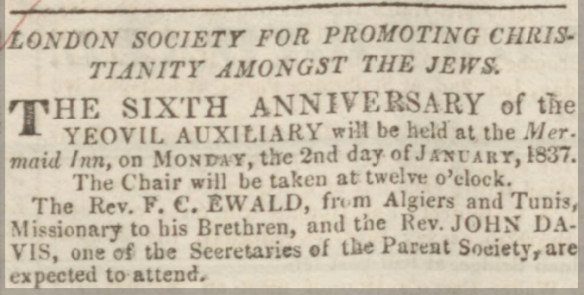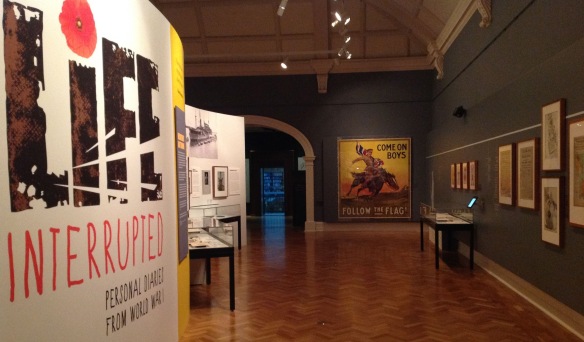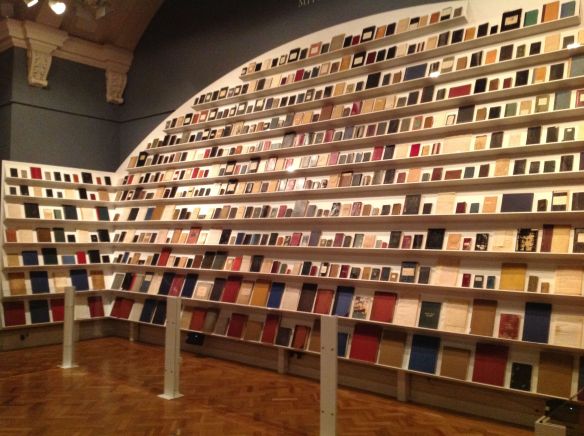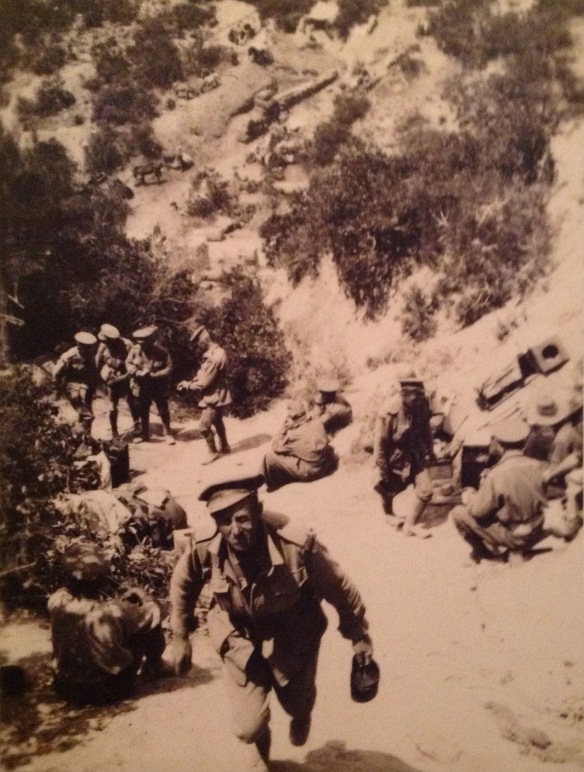Following my last post hart buck – spirit merchant – 1833 I was contacted by Laura in England who owns a very interesting piece of BUCK family history.
Laura is a collector of old bottles. She has an impressive old spirit flagon in her collection which is hand inscribed with the letters “T & H B G”.

Two gallon tapered waisted type spirit flagon hand-inscribed with the letters “T & H B G”
Laura has done some research and believes the initials link the flagon to the business of Thomas and Hart Buck, Spirit Merchants of Grantham, Lincolnshire. She provided me will the following information:
Hi Susan
After doing some research at The British Library in London I have found the earliest reference to Thomas and Hart Buck at Market Place in Grantham in 1822-23. See my photos below taken from Pigot & Co’s Commercial Directory.
The flagon itself is a two gallon tapered waisted type spirit flagon. And is manufactured in a ‘Sgraffito’ style i.e. the lettering is hand-scribed by a skilled artisan with a sharp instrument. This, as well as it’s age, makes it a highly desirable item amongst bottle collectors.
We don’t know if the flagon was produced during the period at the business was at Market Place or from when they moved to the High Street in 1833? But would be able to date somewhere between 1822 (as the directory) to 1842 at Thomas Buck’s death.
Hope my photographs are of interest to you and your family.
Kind Regards,
Laura

‘Sgraffito’ style – lettering is hand-scribed by a skilled artisan with a sharp instrument.
Thank you Laura for sharing your treasure with me. It’s wonderful to see this piece of family history in such good condition at over 195 years old.
Pigot and Co’s Commercial Directory of 1822-23 lists Thomas and Hart Buck of Market Place, Grantham trading as Spirit Merchants. Also listed is William Smith, the publican of the White Hart Hotel in High Street, Grantham.

Thomas Buck and his son Hart are listed as Wine and Spirit Merchants in Grantham, Lincolnshire. [Pigot and Co’s Commercial Directory of 1822-23]
Hart BUCK (1787-1858) had a draper’s business in Market Place, Grantham when his first wife Jane SMITH died in February 1824.
The Lincoln, Rutland & Stamford Mercury – Friday 13 February 1824
DEATH: At Grantham on Thursday the 5th inst. Mrs Buck, wife of Mr Hart Buck, of that place, aged 33, leaving seven small children, with a disconsolate husband, to lament the loss of a most valuable wife and tender mother. Her remains were interred at Grantham on Sunday and six of her children were christened at the same time.
Thomas BUCK (1763-1842) was Hart BUCK’s father. I believe Thomas had a business of some sort in Epperstone, Nottinghamshire in the 1780s before moving to Grantham. Thomas was a witness on the church register when Hart married his second wife Mary SMITH (nee HALL) in Grantham on 7th November 1824.
The Lincoln, Rutland & Stamford Mercury – Friday 12 November 1824
MARRIAGE: On Sunday last, at Grantham, Mr Hart Buck, draper of that place to Mrs Smith, daughter of Mr Hall grazier of Pointon, near Folkingham.
It baffled me for a long while how Hart BUCK, a draper of Grantham, took on a spirit and wine business. Then I found some newspaper articles relating to his wife Mary’s first marriage:
The Lincoln, Rutland & Stamford Mercury – 20th October 1815
MARRIAGE: At Brussels on the 4th instant Mr William SMITH, army saddler to Miss Mary HALL, third daughter of Mr William HALL, grazier of Pointon in this County. The ceremony was performed in the Chapel Royal by the Rev Mr TUNNEY, Chaplain to the Forces.
William SMITH was Mary HALL’s first husband. He served with the Duke of Wellington’s forces at the Battle of Waterloo in June 1815. Or, he arrived as part of the occupying forces based in Brussels soon after the victory over Napoleon’s forces. Mary may have been living in Brussels as a governess or a ladies companion, she was 28 years at time of her marriage to William who was 26-27 years.

English artillery officers at the battle of Waterloo [Original drawing after George Jones.]
William and Mary SMITH settled in Grantham after the war and William was the publican of the White Hart Hotel in the High Street, as listed in Pigot & Co’s Directory of 1922-23.
I have found a curious legal notice in the The Lincoln, Rutland & Stamford Mercury dated 9th April 1824. William SMITH, innkeeper of Grantham assigns over all his estate to Hart BUCK and two other executors Lawrence WYLES and Edward JACKSON.

The Lincoln, Rutland & Stamford Mercury – 9th April 1824.
It is curious because it is not worded as a formal bankrupt notice and William SMITH does not appear in the list of bankrupts published in the newspaper of that time.
It might be a case that the executors of William SMITH’s estate stepped in to manage the business before it was declared insolvent. Another possibility is that William, a veteran of the Battle of Waterloo, was not well. Did he have physical wounds or did he suffer from battle shock?
There are no records of William’s death in or around Grantham in 1824, but I found a parish burial of William SMITH at St Paul in the Bail, Lincoln on 15 October 1824:

Extract of burials in the Parish of St Paul in the Bail, Lincoln 1824. [Lincolnshire Archives]
William was most likely committed to the asylum in Lincoln in early April where I imagine he suffered greatly for six months until his death and burial on 15 October 1824 at the age of 35 years.
His widow Mary married Hart BUCK three weeks later in Grantham on 7th November 1824. The marriage was, no doubt, advantageous and a comfort to them both. Hart was widowed in February, lost his youngest son in July, and had six children under 10 years; and Mary lost her livelihood and her husband to the enduring impact of war. 1824 proved to be a very traumatic year for them all.
From information I have found in newspapers, directories and census returns it appears Hart and Mary and family lived a good life. Hart BUCK is listed as both a draper and wine and spirit merchant in Market Place, Grantham until 1833 when the family moved to High Street.

The Lincoln, Rutland & Stamford Mercury – 28th June 1833.
Hart BUCK’s father Thomas BUCK died in Grantham in 1842. Hart and Mary BUCK moved to Newark Upon Trent, Nottinghamshire sometime after the 1841 Census. They are in Newark in the 1851 Census and living back in Grantham and Little Gonerby by 1952.
In his last will and testament dated 1855, Hart BUCK also had the copy hold title to “The Wheatsheaf” in Long Bennington, Lincoln. Hart died in December 1858 in Little Gonerby.
The Grantham Journal – Saturday, 11th December 1858.
DEATH: At Grantham, on Sunday last, Mr Hart Buck senr; aged 71 yrs.
OBITUARY: We this week record the decease of the oldest tradesman in the town of Grantham – Mr Hart Buck – in the 72nd year of his age. For more than half a century in his business transactions he maintained the respect and esteem of the community amongst which he resided. His decease was somewhat unexpected, a circumstance which invariably adds to the grief of a bereaved family.
. . . . . . . . . . . . . . . . . .
Sources:The British Newspaper Archive website; Parish Records Lincolnshire Archives; photos of flagon and Pigot & Co’s directory by Laura Barton.

![Hart Buck Spirit Merchant advertisement [Stamford Mercury 28 June 1833]](https://branchesofourfamily.wordpress.com/wp-content/uploads/2014/01/buck_hart_spirit-merchant_buck_18330628_spirit-merchant_stamford-mercury.png?w=584)
![Old rum bottles, Stage-coach and Tavern Days, by Alice Morse Earle,1900 [Project Gutenberg]](https://branchesofourfamily.wordpress.com/wp-content/uploads/2015/08/old_rum_bottles1.jpg?w=584)







![Recruits undergoing medical examination at Victoria Barracks, Sydney, (1914-1918) [AWM negative A03616]](https://branchesofourfamily.wordpress.com/wp-content/uploads/2014/09/a03616.jpg?w=584&h=446)
![New recruits moving through the Army camp lines at Liverpool, New South Wales, c1914 [AWM H03358]](https://branchesofourfamily.wordpress.com/wp-content/uploads/2014/09/h03358.jpg?w=584&h=371)







![News report from the South Petherton Church vestry meeting notes that Frederick Welligntong had recently left town. [Western Gazette, 22 April 1887]](https://branchesofourfamily.wordpress.com/wp-content/uploads/2014/08/1887-04-22_western-gazette_wellington-fgn-left-sp1.png?w=584&h=289)
![Notice of the sudden death of Frederick GN Wellington in Bristol. [Western Gazette, 27 May 1887]](https://branchesofourfamily.wordpress.com/wp-content/uploads/2014/08/1887-05-27_western-gazette_wellington-fgn-death1.jpg?w=584&h=510)





















